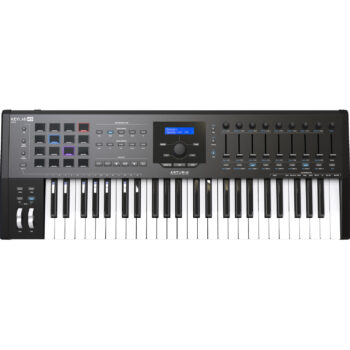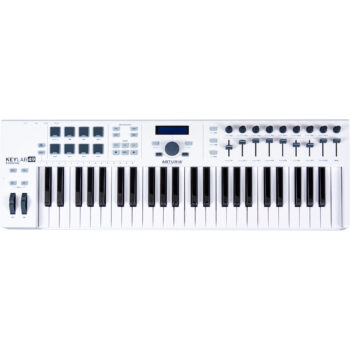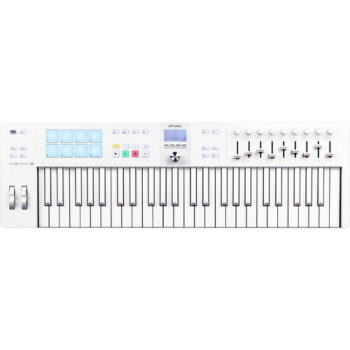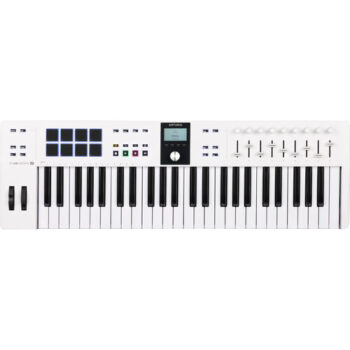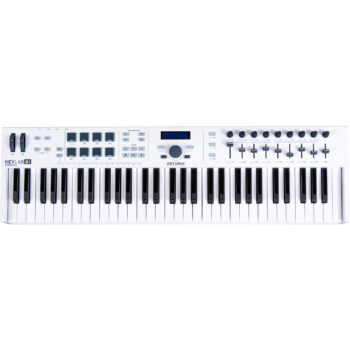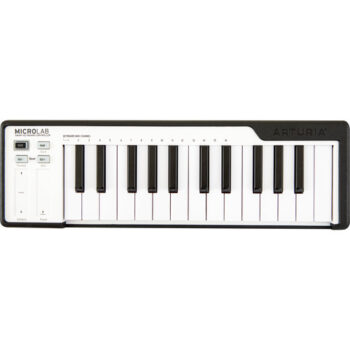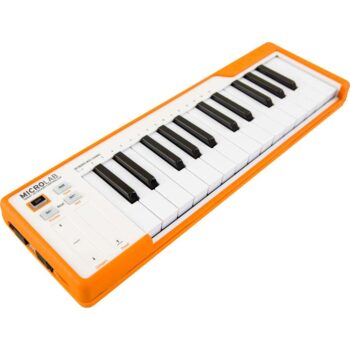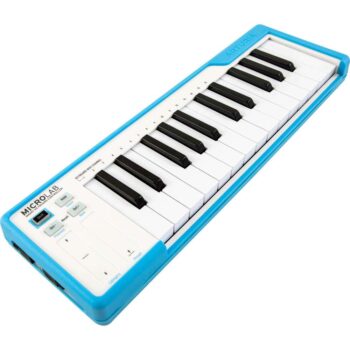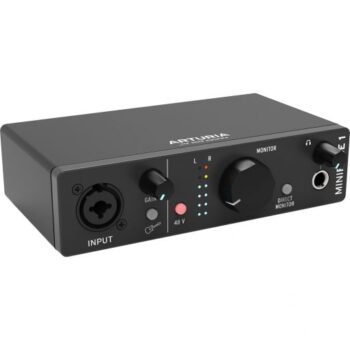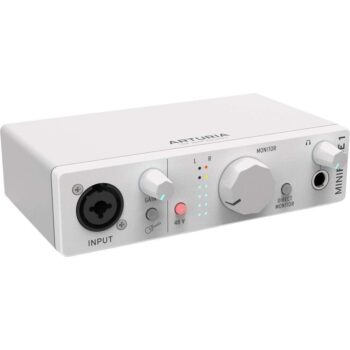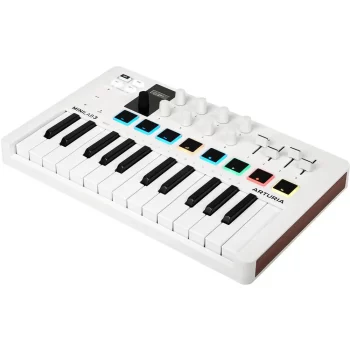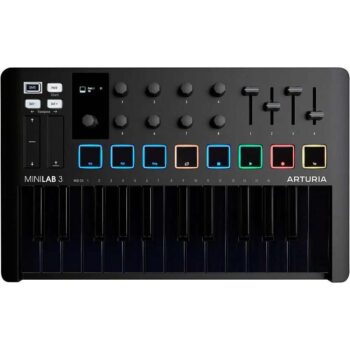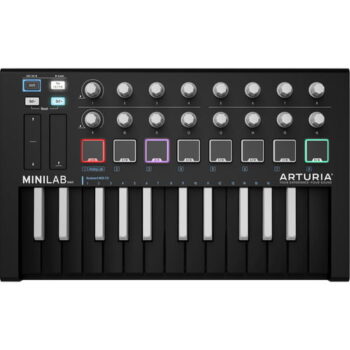History
Arturia was founded in 1999 in Grenoble by INPG engineers Frédéric Brun and Gilles Pommereuil to create affordable software synthesizers. The first product they developed was Storm, a virtual instrument workstation.[2] The close emulation of classic analog synthesizers helped the company gain popularity in its market.[3] In order to create sounds with minimal digital artifacts, Brun and Pommereuil developed new software algorithms to eliminate these issues.[4]
In 2003, using the algorithms they had developed, Arturia worked with Robert Moog to create the Modular V softsynth. The Modular V uses Arturia’s True Analog Emulation (TAE) in an attempt to faithfully reproduce the oscillators, filters, and other modules from the Moog 3C and Moog 55.[4][5] Following these releases, Arturia continued to develop software emulations of well known synthesizers, including the ARP 2600, Roland Jupiter-8, Minimoog, and Sequential Circuits Prophet-5.
In 2007, Arturia combined sounds from several of their softsynth titles into Analog Factory, which offered 2000 preset synthesizer patches,[6] offering this the following year as Analog Experience, a hybrid system which combined the software with a MIDI keyboard controller specifically designed to play and control it.[7]
Arturia entered the hardware synthesizer market in 2012 with the MiniBrute, a vintage-style 25-key monophonic analog synthesizer with one voltage controlled oscillator, two low-frequency oscillators, and a multimode Steiner-Parker filter.[8] The synthesizer was introduced at the 2012 NAMM Show.[9] Despite pre-production uncertainty about sales, the MiniBrute sold well due to its low price point and expressive sound.[10] In the following year, Arturia announced their next hardware synthesizer, the MicroBrute, a smaller and less expensive version of the MiniBrute with minikeys, a patch bank, and a sequencer.[11] Both synthesizers received critical acclaim.[10]
ARTURIA
Showing all 18 results
-
Proaudio, Arturia, USB MIDI Keyboards - Controllers
Arturia Beatstep – Controller and Sequencer
Key Features:- 16 Velocity and Pressure-Sensitive Pads
- 16 Rotary Encoders
- 16 MIDI Controller Presets
- 16 Sequence Presets
- MIDI Controller Mode with Red LEDs
- MIDI and CV Outputs
The Arturia Beatstep USB, MIDI, and CV Controller and Sequencer is a USB class-compliant driverless controller that enables control over DAWs, loop triggering software, drum software, VST instruments and analog equipment that has control voltage (CV) connections.
SKU: 430101 -
USB MIDI Keyboards - Controllers, Arturia, Proaudio
Arturia KeyLab 49 MKII
Key Features- 49-Note Keybed with Vel & AT
- Includes Analog Lab Software
- Over 6500 TAE-Powered Preset Sounds
- 9 Faders and 9 Encoders
- 16 Velocity- & Pressure-Sensitive Pads
- Includes Ableton Live Lite
- V-Piano Virtual Instrument
- 10 Magnetic Overlays for DAW Control
- CV Input & Output + 5 Pedal Inputs
- Mac/Widows/Standalone: VST, AU, AAX
The Arturia KeyLab MKII is a universal MIDI controller and software package that includes 49 velocity-sensitive keys with aftertouch, a clickable encoder, 9 additional encoders, 9 sliders, 16 RGB-backlit touch and pressure sensitive pads, 6 transport control switches, 4 command switches, a modulation wheel, and a pitch-bend wheel.
SKU: 230621 -
USB MIDI Keyboards - Controllers, Arturia, Proaudio
Arturia KeyLab Essential 49
Key Features- 49 Synth-Action Keys with Velocity
- Includes Analog Lab Software
- Over 6000 TAE-Powered Preset Sounds
- 9 Faders and 9 Encoders
- 8 Velocity- & Pressure-Sensitive Pads
- Includes Ableton Live Lite
- UVI Grand Piano
- Virtual Instrument Deep Integration
- Mac & Windows Compatible
- Standalone/Plug-Ins: VST, VST3, AU, AAX
SKU: Ess49 -
USB MIDI Keyboards - Controllers, Arturia, Proaudio
Arturia KeyLab Essential 49 mk3 49-Key Universal MIDI Controller (Alpine White)
USB MIDI Keyboards - Controllers, Arturia, ProaudioArturia KeyLab Essential 49 mk3 49-Key Universal MIDI Controller (Alpine White)
Key Features- 49 Synth-Action Keys with Velocity
- Includes Analog Lab V Software
- Over 2000 Presets
- 9 Faders and 9 Encoders
- 8 Velocity- & Pressure-Sensitive Pads
- Includes Ableton Live Lite
- UVI Grand Piano & NI The Gentleman Piano
- Virtual Instrument Deep Integration
- Mac & Windows Compatible
- Standalone/Plug-Ins: VST, VST3, AU, AAX
The Arturia KeyLab Essential 49 mk3 Alpine White keyboard controller is a great option for musicians, producers, and sound designers seeking a high-quality keyboard controller with enhanced software and unique DAW integration.
SKU: AKLE49mk3 -
USB MIDI Keyboards - Controllers, Arturia, Proaudio
Arturia KeyLab Essential 49 mk3 49-Key Universal MIDI Controller (Black)
USB MIDI Keyboards - Controllers, Arturia, ProaudioArturia KeyLab Essential 49 mk3 49-Key Universal MIDI Controller (Black)
Key Features- 49 Synth-Action Keys with Velocity
- Includes Analog Lab V Software
- Over 2000 Presets
- 9 Faders and 9 Encoders
- 8 Velocity- & Pressure-Sensitive Pads
- Includes Ableton Live Lite
- UVI Grand Piano & NI The Gentleman Piano
- Virtual Instrument Deep Integration
- Mac & Windows Compatible
- Standalone/Plug-Ins: VST, VST3, AU, AAX
Whether you’re a beginner producer, an experienced music maker, or anyone in between, unlock your full creative potential with a Arturia KeyLab Essential 49 mk3 Black MIDI controller that breaks down all the barriers between you, your DAW, and your perfect sound.
SKU: AKLE49mk3-Bk -
USB MIDI Keyboards - Controllers, Arturia, Proaudio
Arturia KeyLab Essential 49 mk3 49-Key Universal MIDI Controller (White)
USB MIDI Keyboards - Controllers, Arturia, ProaudioArturia KeyLab Essential 49 mk3 49-Key Universal MIDI Controller (White)
Key Features- 49 Synth-Action Keys with Velocity
- Includes Analog Lab V Software
- Over 2000 Presets
- 9 Faders and 9 Encoders
- 8 Velocity- & Pressure-Sensitive Pads
- Includes Ableton Live Lite
- UVI Grand Piano & NI The Gentleman Piano
- Virtual Instrument Deep Integration
- Mac & Windows Compatible
- Standalone/Plug-Ins: VST, VST3, AU, AAX
For artists, producers, and sound designers looking for a premium keyboard controller with improved software and distinctive DAW integration, the Arturia KeyLab Essential 49 mk3 White keyboard controller is an excellent choice.
SKU: AKLE49mk3-W -
Proaudio, Arturia, USB MIDI Keyboards - Controllers
Arturia KeyLab Essential 61 – Universal MIDI Controller (White)
Proaudio, Arturia, USB MIDI Keyboards - ControllersArturia KeyLab Essential 61 – Universal MIDI Controller (White)
Key Features-
- 61 Synth-Action Keys with Velocity
- Includes Analog Lab Software
- Over 6000 TAE-Powered Preset Sounds
- 9 Faders and 9 Encoders
- 8 Velocity- & Pressure-Sensitive Pads
- Includes Ableton Live Lite
- UVI Grand Piano
- Virtual Instrument Deep Integration
- Mac & Windows Compatible
- Standalone/Plug-Ins: VST, VST3, AU, AAX
Arturia KeyLab Essential 61 Key MIDI Controller – 61 Synth-Action Keys with Velocity – Includes Analog Lab Software – Over 6000 TAE-Powered Preset Sounds – 9 Faders and 9 Encoders
SKU: KEYLAB 61 ESSENTIAL -
-
Arturia, Proaudio, USB MIDI Keyboards - Controllers
Arturia MicroLab – Black
Key Features- 25 Velocity-Sensitive Mini Keys
- Pitchbend and Modulation Touch Strips
- Octave Up/Down Buttons
- Hold (Sustain) Button + Chord Function
The black Arturia MicroLab is a compact, portable USB-MIDI controller that ships with a comprehensive audio production software suite. The velocity-sensitive 25-key controller is USB bus-powered and features responsive capacitive touch strips for pitchbend and modulation.
SKU: Micro-Lab -
USB MIDI Keyboards - Controllers, Arturia, Proaudio
Arturia MicroLab – Compact USB-MIDI Controller (Orange)
USB MIDI Keyboards - Controllers, Arturia, ProaudioArturia MicroLab – Compact USB-MIDI Controller (Orange)
Key Features- 25 Velocity-Sensitive Mini Keys
- Pitchbend and Modulation Touch Strips
- Octave Up/Down Buttons
- Hold (Sustain) Button + Chord Function
- Integrated USB Cable Channel for Storage
- Mac and Windows Compatible
- USB Bus Powered
- Includes USB Cable and Analog Lab Lite
- Includes UVI Grand Piano Model D
- Includes Bitwig Studio 8-Track
The Arturia MicroLab Orange is a compact, portable USB-MIDI controller that ships with a comprehensive audio production software suite. The velocity-sensitive 25-key controller is USB bus-powered and features responsive capacitive touch strips for pitchbend and modulation.
SKU: 230513 -
Proaudio, Arturia, USB MIDI Keyboards - Controllers
Arturia MicroLab | Blue
Key Features- 25 Velocity-Sensitive Mini Keys
- Pitchbend and Modulation Touch Strips
- Octave Up/Down Buttons
- Hold (Sustain) Button + Chord Function
- Integrated USB Cable Channel for Storage
- Mac and Windows Compatible
- USB Bus Powered
- Includes USB Cable and Analog Lab Lite
- Includes UVI Grand Piano Model D
- Includes Bitwig Studio 8-Track
The Arturia MicroLab blue colour 25 Keys USB-MIDI Controller is a portable USB-MIDI controller that ships with a comprehensive audio production software suite.
SKU: 230511 -
USB Audio Interfaces, Arturia, Audio & Midi Interfaces, Proaudio
Arturia MiniFuse 1 Portable USB-C Audio Interface – Black
USB Audio Interfaces, Arturia, Audio & Midi Interfaces, ProaudioArturia MiniFuse 1 Portable USB-C Audio Interface – Black
Key Features- Singers, Guitarists, Solo Podcasters
- USB Type-C Connectivity
- 1 Mic / Line / Instrument Preamp
- 1 Headphone Out, Stereo Monitor Out
- 24-Bit / 192 kHz Converters
- Bus Powered / Mac, Windows
- Phantom Power, Direct Monitor
- Built-In USB Hub for Keyboard Controller
- Loopback Function for Content Creators
- DAW, Amp Sim, VIs, and FX
SKU: 800101 -
USB Audio Interfaces, Audio & Midi Interfaces, Proaudio
Arturia MiniFuse 1 USB Type-C Audio Interface – White
USB Audio Interfaces, Audio & Midi Interfaces, ProaudioArturia MiniFuse 1 USB Type-C Audio Interface – White
Key Features- Singers, Guitarists, Solo Podcasters
- USB Type-C Connectivity
- 1 Mic / Line / Instrument Preamp
- 1 Headphone Out, Stereo Monitor Out
- 24-Bit / 192 kHz Converters
- Bus Powered / Mac, Windows
- Phantom Power, Direct Monitor
- Built-In USB Hub for Keyboard Controller
- Loopback Function for Content Creators
- DAW, Amp Sim, VIs, and FX
SKU: 800111 -
USB Audio Interfaces, Arturia, Audio & Midi Interfaces, Proaudio
Arturia MiniFuse 2 Portable 2×2 USB Type-C Audio/MIDI Interface – Black
USB Audio Interfaces, Arturia, Audio & Midi Interfaces, ProaudioArturia MiniFuse 2 Portable 2×2 USB Type-C Audio/MIDI Interface – Black
Key Features- Producers, Musicians, Podcaster Duos
- USB Type-C Connectivity
- 2 Mic / Line / Instrument Preamps
- 1 Headphone Out, Stereo Monitor Out
- 24-Bit / 192 kHz Converters
- Bus Powered / Mac, Windows
- Phantom Power, Direct Monitor & MIDI I/O
- Built-In USB Hub for Keyboard Controller
- Loopback Function for Content Creators
- DAW, Amp Sim, VIs, and FX
SKU: 800102 -
USB MIDI Keyboards - Controllers, Arturia, Proaudio
Arturia MiniLab 3 – 25 key MIDI Controller – White Edition
USB MIDI Keyboards - Controllers, Arturia, ProaudioArturia MiniLab 3 – 25 key MIDI Controller – White Edition
Key Features- 25 Velocity-Sensitive Slim Keys
- 2 Banks of 8 Backlit Performance Pads
- 8 Rotary Encoders and 4 Sliders
- Mini Display + Clickable Browsing Knob
- Built-In Arp + Hold and Chord Modes
- DAW Integration Scripts
- Pitch-Bend and Modulation Touchstrips
- Octave Up/Down Buttons, Sustain Pedal In
- Includes Production-Ready Bundle
- USB Bus Powered, Mac and Windows
SKU: 835911 -
USB MIDI Keyboards - Controllers, Arturia, Proaudio
Arturia MiniLab 3 25 Slim-key MIDI Keyboard Controller – Black Edition
USB MIDI Keyboards - Controllers, Arturia, ProaudioArturia MiniLab 3 25 Slim-key MIDI Keyboard Controller – Black Edition
Key Features- 25 Velocity-Sensitive Slim Keys
- 2 Banks of 8 Backlit Performance Pads
- 8 Rotary Encoders and 4 Sliders
- Mini Display + Clickable Browsing Knob
- Built-In Arp + Hold and Chord Modes
- DAW Integration Scripts
- Pitch-Bend and Modulation Touchstrips
- Octave Up/Down Buttons, Sustain Pedal In
- Includes Production-Ready Bundle
- USB Bus Powered, Mac and Windows
SKU: 835913 -
USB MIDI Keyboards - Controllers, Arturia, Proaudio
Arturia MiniLab 3 25 Slim-key MIDI Keyboard Controller – Deep Black
USB MIDI Keyboards - Controllers, Arturia, ProaudioArturia MiniLab 3 25 Slim-key MIDI Keyboard Controller – Deep Black
Features- 5 Velocity-Sensitive Slim Keys
- 2 Banks of 8 Backlit Performance Pads
- 8 Rotary Encoders and 4 Sliders
- Mini Display + Clickable Browsing Knob
- Built-In Arp + Hold and Chord Modes
- DAW Integration Scripts
- Pitch-bend and Modulation Touch trips
- Octave Up/Down Buttons, Sustain Pedal In
- Includes Production-Ready Bundle
- USB Bus Powered, Mac and Windows
SKU: AM3DBk -
USB MIDI Keyboards - Controllers, Arturia, Proaudio
Arturia MiniLab MkII
Key Features:- 25 Velocity-Sensitive Slim Keys
- 2 Banks of 8 Backlit Performance Pads
- 16 Rotary Encoders
- Pitch Bend and Modulation Touch
- Portable and Compact – MIDI Controller
- The most responsive keyboard experience in its category
- 500 of the V-Collection 8 presets / 21 Keyboard Instruments and Synthesizers / fully mapped right out of the box
- The perfect solution to get started with music production
- 16 Assignable Encoders to control your DAW
SKU: 230501 -
Proaudio, Arturia, USB MIDI Keyboards - Controllers
Arturia Minilab MkII Inverted-MIDI Controller Keyboard
Proaudio, Arturia, USB MIDI Keyboards - ControllersArturia Minilab MkII Inverted-MIDI Controller Keyboard
Key Features- 25 Velocity-Sensitive Slim Keys
- 2 Banks of 8 Backlit Performance Pads
- 16 Rotary Encoders
- Pitch Bend and Modulation Touch Sensors
Arturia Minilab MkII Inverted MIDI Controller Keyboard is a compact, portable USB-MIDI controller that ships with a comprehensive audio production software suite.
SKU: ARMINILABMK2



